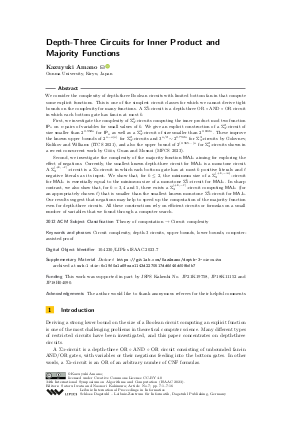Depth-Three Circuits for Inner Product and Majority Functions
Author
Kazuyuki Amano 
-
Part of:
Volume:
34th International Symposium on Algorithms and Computation (ISAAC 2023)
Part of: Series: Leibniz International Proceedings in Informatics (LIPIcs)
Part of: Conference: International Symposium on Algorithms and Computation (ISAAC) - License:
 Creative Commons Attribution 4.0 International license
Creative Commons Attribution 4.0 International license
- Publication Date: 2023-11-28
File

PDF
LIPIcs.ISAAC.2023.7.pdf
- Filesize: 0.79 MB
- 16 pages
Document Identifiers
Subject Classification
ACM Subject Classification
- Theory of computation → Circuit complexity
Keywords
- Circuit complexity
- depth-3 circuits
- upper bounds
- lower bounds
- computer-assisted proof
Metrics
- Access Statistics
-
Total Accesses (updated on a weekly basis)
0PDF Downloads0Metadata Views
Abstract
We consider the complexity of depth-three Boolean circuits with limited bottom fan-in that compute some explicit functions. This is one of the simplest circuit classes for which we cannot derive tight bounds on the complexity for many functions. A Σ₃^k-circuit is a depth-three OR ∘ AND ∘ OR circuit in which each bottom gate has fan-in at most k.
First, we investigate the complexity of Σ₃^k-circuits computing the inner product mod two function IP_n on n pairs of variables for small values of k. We give an explicit construction of a Σ²₃-circuit of size smaller than 2^{0.952n} for IP_n as well as a Σ³₃-circuit of size smaller than 2^{0.692n}. These improve the known upper bounds of 2^{n-o(n)} for Σ₃²-circuits and 3^{n/2} ∼ 2^{0.792n} for Σ₃³-circuits by Golovnev, Kulikov and Williams (ITCS 2021), and also the upper bound of 2^{(0.965…)n} for Σ₃²-circuits shown in a recent concurrent work by Göös, Guan and Mosnoi (MFCS 2023).
Second, we investigate the complexity of the majority function MAJ_n aiming for exploring the effect of negations. Currently, the smallest known depth-three circuit for MAJ_n is a monotone circuit. A Σ₃^{(+k,-𝓁)}-circuit is a Σ₃-circuit in which each bottom gate has at most k positive literals and 𝓁 negative literals as its input. We show that, for k ≤ 2, the minimum size of a Σ₃^{(+k,-∞)}-circuit for MAJ_n is essentially equal to the minimum size of a monotone Σ₃^k-circuit for MAJ_n. In sharp contrast, we also show that, for k = 3,4 and 5, there exists a Σ₃^{(+k, -𝓁)}-circuit computing MAJ_n (for an appropriately chosen 𝓁) that is smaller than the smallest known monotone Σ₃^k-circuit for MAJ_n. Our results suggest that negations may help to speed up the computation of the majority function even for depth-three circuits. All these constructions rely on efficient circuits or formulas on a small number of variables that we found through a computer search.
Cite As Get BibTex
Kazuyuki Amano. Depth-Three Circuits for Inner Product and Majority Functions. In 34th International Symposium on Algorithms and Computation (ISAAC 2023). Leibniz International Proceedings in Informatics (LIPIcs), Volume 283, pp. 7:1-7:16, Schloss Dagstuhl – Leibniz-Zentrum für Informatik (2023)
https://doi.org/10.4230/LIPIcs.ISAAC.2023.7
BibTex
@InProceedings{amano:LIPIcs.ISAAC.2023.7,
author = {Amano, Kazuyuki},
title = {{Depth-Three Circuits for Inner Product and Majority Functions}},
booktitle = {34th International Symposium on Algorithms and Computation (ISAAC 2023)},
pages = {7:1--7:16},
series = {Leibniz International Proceedings in Informatics (LIPIcs)},
ISBN = {978-3-95977-289-1},
ISSN = {1868-8969},
year = {2023},
volume = {283},
editor = {Iwata, Satoru and Kakimura, Naonori},
publisher = {Schloss Dagstuhl -- Leibniz-Zentrum f{\"u}r Informatik},
address = {Dagstuhl, Germany},
URL = {https://drops.dagstuhl.de/entities/document/10.4230/LIPIcs.ISAAC.2023.7},
URN = {urn:nbn:de:0030-drops-193092},
doi = {10.4230/LIPIcs.ISAAC.2023.7},
annote = {Keywords: Circuit complexity, depth-3 circuits, upper bounds, lower bounds, computer-assisted proof}
}
Author Details
Funding
This work was supported in part by JSPS Kakenhi No. JP21K19758, JP18K11152 and JP18H04090.
Acknowledgements
The author would like to thank anonymous referees for their helpful comments.
Supplementary Materials
-
Dataset
https://gitlab.com/KazAmano/depth-3-circuits
browse
 archived version
archived version
References
- Noga Alon and Ravi B. Boppana. The monotone circuit complexity of boolean functions. Comb., 7(1):1-22, 1987. URL: https://doi.org/10.1007/BF02579196.
- Kazuyuki Amano. On the size of depth-two threshold circuits for the inner product mod 2 function. In Alberto Leporati, Carlos Martín-Vide, Dana Shapira, and Claudio Zandron, editors, Language and Automata Theory and Applications - 14th International Conference, LATA 2020, volume 12038 of Lecture Notes in Computer Science, pages 235-247. Springer, 2020. URL: https://doi.org/10.1007/978-3-030-40608-0_16.
- Ravi B. Boppana. Threshold functions and bounded depth monotone circuits. J. Comput. Syst. Sci., 32(2):222-229, 1986. URL: https://doi.org/10.1016/0022-0000(86)90027-9.
- Bruno Pasqualotto Cavalar and Igor C. Oliveira. Constant-depth circuits vs. monotone circuits. In Amnon Ta-Shma, editor, 38th Computational Complexity Conference, CCC 2023, July 17-20, 2023, Warwick, UK, volume 264 of LIPIcs, pages 29:1-29:37. Schloss Dagstuhl - Leibniz-Zentrum für Informatik, 2023. URL: https://doi.org/10.4230/LIPIcs.CCC.2023.29.
-
Jeffrey H. Dinitz Charles J. Colbourn. Handbook of Combinatorial Designs (Discrete Mathematics and Its Applications). Chapman and Hall/CRC, 2006.

- Vlado Dancík. Complexity of boolean functions over bases with unbounded fan-in gates. Inf. Process. Lett., 57(1):31-34, 1996. URL: https://doi.org/10.1016/0020-0190(95)00182-4.
-
Paul Erdős and Joel Spencer. Probabilistic Methods in Combinatorics. Academic Press, 1974.

- Magnus Gausdal Find, Alexander Golovnev, Edward A. Hirsch, and Alexander S. Kulikov. A better-than-3n lower bound for the circuit complexity of an explicit function. In Irit Dinur, editor, IEEE 57th Annual Symposium on Foundations of Computer Science, FOCS 2016, pages 89-98. IEEE Computer Society, 2016. URL: https://doi.org/10.1109/FOCS.2016.19.
- Jürgen Forster. A linear lower bound on the unbounded error probabilistic communication complexity. J. Comput. Syst. Sci., 65(4):612-625, 2002. URL: https://doi.org/10.1016/S0022-0000(02)00019-3.
- Peter Frankl, Svyatoslav Gryaznov, and Navid Talebanfard. A variant of the vc-dimension with applications to depth-3 circuits. In Mark Braverman, editor, 13th Innovations in Theoretical Computer Science Conference, ITCS 2022, volume 215 of LIPIcs, pages 72:1-72:19. Schloss Dagstuhl - Leibniz-Zentrum für Informatik, 2022. URL: https://doi.org/10.4230/LIPIcs.ITCS.2022.72.
- Alexander Golovnev, Alexander S. Kulikov, and R. Ryan Williams. Circuit depth reductions. In James R. Lee, editor, 12th Innovations in Theoretical Computer Science Conference, ITCS 2021, volume 185 of LIPIcs, pages 24:1-24:20. Schloss Dagstuhl - Leibniz-Zentrum für Informatik, 2021. URL: https://doi.org/10.4230/LIPIcs.ITCS.2021.24.
- Mika Göös, Ziyi Guan, and Tiberiu Mosnoi. Depth-3 circuits for inner product. In Jérôme Leroux, Sylvain Lombardy, and David Peleg, editors, 48th International Symposium on Mathematical Foundations of Computer Science, MFCS 2023, August 28 to September 1, 2023, Bordeaux, France, volume 272 of LIPIcs, pages 51:1-51:12. Schloss Dagstuhl - Leibniz-Zentrum für Informatik, 2023. URL: https://doi.org/10.4230/LIPIcs.MFCS.2023.51.
- Daniel M. Gordon. Covering designs. URL: https://www.dmgordon.org/cover/.
- Gurobi Optimization, LLC. Gurobi Optimizer Reference Manual, 2023. URL: https://www.gurobi.com.
- András Hajnal, Wolfgang Maass, Pavel Pudlák, Mario Szegedy, and György Turán. Threshold circuits of bounded depth. J. Comput. Syst. Sci., 46(2):129-154, 1993. URL: https://doi.org/10.1016/0022-0000(93)90001-D.
- Johan Håstad, Stasys Jukna, and Pavel Pudlák. Top-down lower bounds for depth-three circuits. Comput. Complex., 5(2):99-112, 1995. URL: https://doi.org/10.1007/BF01268140.
- Shuichi Hirahara. A duality between depth-three formulas and approximation by depth-two. CoRR, abs/1705.03588, 2017. URL: https://arxiv.org/abs/1705.03588.
- Daniel M. Kane and Ryan Williams. Super-linear gate and super-quadratic wire lower bounds for depth-two and depth-three threshold circuits. In Daniel Wichs and Yishay Mansour, editors, Proceedings of the 48th Annual ACM SIGACT Symposium on Theory of Computing, STOC 2016, pages 633-643. ACM, 2016. URL: https://doi.org/10.1145/2897518.2897636.
- Maria M. Klawe, Wolfgang J. Paul, Nicholas Pippenger, and Mihalis Yannakakis. On monotone formulae with restricted depth (preliminary version). In Richard A. DeMillo, editor, Proceedings of the 16th Annual ACM Symposium on Theory of Computing, STOC 1984, pages 480-487. ACM, 1984. URL: https://doi.org/10.1145/800057.808717.
- Jiatu Li and Tianqi Yang. 3.1n - o(n) circuit lower bounds for explicit functions. In Stefano Leonardi and Anupam Gupta, editors, STOC '22: 54th Annual ACM SIGACT Symposium on Theory of Computing, Rome, Italy, June 20-24, 2022, pages 1180-1193. ACM, 2022. URL: https://doi.org/10.1145/3519935.3519976.
- Ramamohan Paturi, Michael E. Saks, and Francis Zane. Exponential lower bounds for depth 3 boolean circuits. In Frank Thomson Leighton and Peter W. Shor, editors, Proceedings of the Twenty-Ninth Annual ACM Symposium on the Theory of Computing, STOC 1997, pages 86-91. ACM, 1997. URL: https://doi.org/10.1145/258533.258556.
-
W. V. Quine. Two theorems about truth-functions. Boletín de la Sociedad Matemática Mexicana, 10(1-2):64-70, 1953.

- Alexander A. Razborov. On the method of approximations. In David S. Johnson, editor, Proceedings of the 21st Annual ACM Symposium on Theory of Computing, STOC 1989, pages 167-176. ACM, 1989. URL: https://doi.org/10.1145/73007.73023.
- Vojtech Rödl. On a packing and covering problem. Eur. J. Comb., 6(1):69-78, 1985. URL: https://doi.org/10.1016/S0195-6698(85)80023-8.
- Igor' S. Sergeev. On the complexity of bounded-depth circuits and formulas over the basis of fan-in gates. Discrete Mathematics and Applications, 29:241-254, 2019. URL: https://doi.org/10.1515/dma-2019-0022.
